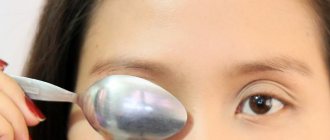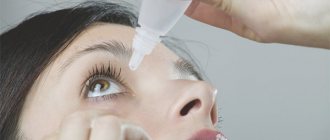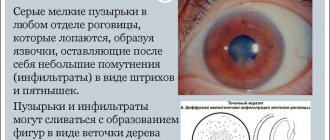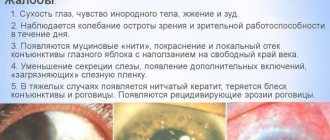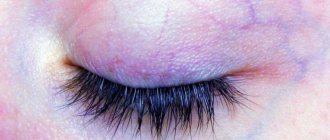Causes of swelling of the eyelids
1. Inflammatory, when a fold of skin turns red, itches, hurts and the person feels as if something has gotten into the eye.
2. Non-inflammatory, in which there is no discomfort or redness, but the eyelid is significantly increased in size.
If the upper eyelid looks abnormal too often, but does not cause pain, the causes are not pathological. This is an abundance of liquids drunk at night, including alcoholic drinks, lack of sleep, eye strain during working hours, long sittings at the computer. However, you should not hope that the tumor will go away on its own. Sometimes it signals improper functioning of internal organs.
If the eyelid is swollen, the reasons for eye health may be:
- Allergy. Sudden redness of the skin with rapid swelling is the body's reaction to an allergen. A cooling compress and an antihistamine tablet will help relieve symptoms. To prevent repeated episodes and complications, it is recommended to take allergy tests and determine the cause of the incident.
- Conjunctivitis. The pathology affects the mucous membrane. Its nature is viral, bacterial or allergic. “Rabbit eyes,” as people say, do not allow the eyelids to open normally after sleep, since the eyelashes are glued together with dried discharge. During the day, the organ may itch and bleed tears and purulent discharge. Treatment of conjunctivitis is carried out by washing the eye with special solutions and treating with drops or ointment.
- Barley. Due to bacterial infection, inflammation of the meibomian gland develops. An acute process leads to its blockage, swelling of the skin fold and the appearance of a red lump at the edge. The element is soft to the touch. The presence of barley indicates a weak immune system. For treatment, doctors prescribe antibacterial drops and ointments (ophthalmic).
- Graves' disease or Graves' disease. Pathology of the endocrine system, in particular the thyroid gland, develops due to iodine deficiency. Its signs are manifested not only by swelling of the eyelids, but also by bulging eyeballs, increased moisture in the skin tissue and insomnia.
- Chalazion. Initially it appears as a stye, but later it spreads to the cartilage of the eyelid and becomes chronic. The primary symptoms of chalazion are burning, discomfort in the eye, slight redness and swelling. After a few days they subside, but the affected area thickens, rounds, becomes painless and elastic.
- Blepharitis. This concept unites various ailments that are characterized by chronic inflammation of the extreme part of the eyelid. In the patient, they are red, swollen, itchy, flaky and may ache. Blepharitis develops due to bacterial infection. The most common culprit is Staphylococcus aureus.
- Ocular herpes. The virus affects not only the skin, but also mucous membranes and various organs. Its strains are activated in a weakened body, the immune system of which does not perform protective functions well. There is significant swelling of the eyelid, it is painful for a person to blink, and vision is blurred. Treatment of herpes is based on the use of antiviral drugs (Acyclovir, Zovirax, Penciclovir ointments). The advanced stage is dangerous for retinal detachment, glaucoma, and cataracts.
- Cancer. The oncological process on the eyelid (upper or lower) occurs in three forms - infiltrative, warty and ulcerative. Initially, a benign neoplasm on the eye eventually degenerates into a malignant tumor. Ulcerative cancer is manifested by a change in the color of the skin of the eyelid - it becomes grayish. The site rises and acquires a nodular element. Warty cancer, as it progresses, spreads to the eyeball, orbit, conjunctiva and paranasal sinuses. Untreated disease can lead to damage to regional lymph nodes. Malignant processes in the upper/lower eyelid include sarcoma, melanosarcoma, melanoma and meibomian gland cancer. The tumor grows for a long time, from one to several months. At the initial stage, eyelid cancer is asymptomatic or manifests itself as strabismus or loss of vision. Further, lacrimation, pain, inflammation are observed and glaucoma is diagnosed. The third phase of development of cancer pathology is the most unfavorable. Metastases spread to regional lymph nodes and accumulate in distant organs. The prognosis in this case is unfavorable. Treatment of malignant diseases of the eyelid is carried out by laser excision of the problem area and radiation and chemotherapy.
Two types of swelling:
- Inflammatory: the eyelid above the eye swells, turns red and quickly enlarges. Pain and itching may occur.
- Non-inflammatory: noticeable enlargement of the eyelid.
If you experience regular swelling of the eyelids, which is accompanied by pain, you should immediately contact a medical facility. If the eyelid above the eye is swollen, this may be preceded by:
- disturbance of sleep and rest patterns;
- overstrain of the organ of vision (long-term work at a computer monitor);
- drinking large amounts of fluid before bed;
- alcohol-containing drinks retain fluid in the body;
- dysfunction of internal organs.
Swelling under the right eye or swelling under the left eye, the reasons may lie in various pathological processes occurring in the human body.
Somatic diseases
Swelling under the right or left eye can be caused by problems with the thyroid gland. In this case, swelling most often appears in the lower eyelid, especially in the morning.
If the swelling of one eye is caused by renal failure or concomitant diseases, it subsides during the day. If the swelling becomes larger in the evening, it is worth suspecting a problem in the functioning of the cardiovascular system.
If one eyelid swells, this may indicate the appearance of an intervertebral hernia in the cervical spine.
Eye diseases
Allergic reaction
When the left or right eye swells, this may indicate an ongoing local allergic reaction due to an insect bite or contact with an allergen (household chemicals, cosmetics, etc.). There will be itching, redness, and lacrimation.
Diseases of the mouth and nose
Why can swelling occur only in one eyelid, and in what situations does the second eye become infected:
- Viral infections (if they appear in one eyelid, they can soon infect the second): Herpes.
- Molluscum contagiosum.
- Furunculosis.
- Conjunctivitis.
Erysipelas.
- A bite of an insect.
- Cosmetics.
Allergic edema is due to the characteristics of the body; it is possible that the membrane of one eye is much thinner than the other, which is why the edema appears. If contact with the allergen is not eliminated, the risk of swelling in the second (healthy) eyelid will increase significantly.
Edema is the result of the accumulation of excessive amounts of fluid in the intercellular space. Normally, the process of exchange of fluids between various systems of the body occurs through diffusion filtration.
Thanks to this, the liquid is distributed throughout the cells evenly and in the required quantity. The appearance of places of excess accumulation occurs when water-electrolyte metabolism is disrupted, which is manifested by tissue swelling.
The swelling does not necessarily have to spread symmetrically; it often happens that one limb, one side of the body or face swells. The reason for this violation may be:
- mechanical injury;
- allergic reaction;
- infection;
- inflammation in the oral cavity;
- chronic lack of sleep.
With a strong physical impact on the eye area, bridge of the nose, forehead, soft tissue injury and inflammation occurs. They begin to hurt and swell, and fluid from the cells enters the extracellular space, where it accumulates and forms a hematoma. This explains the fact that the morning after the blow a hematoma immediately appeared and the face was swollen.
When an allergic reaction develops along with swelling under the left or right eye, the patient develops symptoms such as:
- lacrimation;
- burning;
- feeling of a foreign object in the eyes;
- itching;
- redness.
This manifestation of allergies can be explained by the fact that the epidermal layer around the eyes is thinner and more sensitive than in other places, so it is more vulnerable to allergens. The area around the eyes has few muscles and many vessels of different diameters, which determines the size of the tumor.
If a severe allergic reaction develops, not only a bag appears under the eye, but the entire face, arms and legs swell. Breathing becomes difficult, which indicates the development of swelling in the respiratory tract.
This condition requires emergency medical care, in the absence of which in 100% of cases the victim’s death occurs. This condition is called “Quincke's edema” and is observed in less than 5% of cases.
Swelling under the eye often accompanies colds, ARVI, and flu. Often a tumor appears in the presence of an inflammatory process in the maxillary sinuses. When the right nasal sinus becomes inflamed, swelling spreads under the right eye, and vice versa. If a person is sick with ARVI or influenza, a bag under the eye will be accompanied by itching, burning in the eyes, fever, and general weakness.
An insect bite often causes an allergic reaction to toxins released through saliva. A slight swelling appears at the site of the bite, which indicates that the body is trying to stop the spread of the poison and bring it out.
Some time after the bite, the skin in its place becomes red, itching and swelling appear. An insect bite in the eye area causes significant swelling, and in the case of a bee sting, a severe allergic reaction is possible, which often ends in anaphylactic shock.
Many people are familiar with the situation when in the morning, instead of their own face, the puffy face of a stranger with heavy swollen eyelids and slitted eyes appears in the mirror. But as the day progresses, this unsightly stranger transforms: the swelling subsides and the face takes on its normal appearance.
The reasons for this unpleasant morning phenomenon may be:
- diseases of the urinary tract, kidneys
- drinking alcohol and salty foods at night
- allergies to used cosmetics
- blood flow disturbance
IMPORTANT: If your eyes regularly swell in the morning for no apparent reason, you need to undergo a medical examination. Perhaps there is a hidden inflammatory process going on in the body.
Sometimes swelling of the eyelids is accompanied by redness of the whites of the eyes, itching and a feeling as if sand had been poured into the eyes. The situation is extremely unpleasant and requires immediate treatment. Otherwise, painful wounds may appear in the areas of scratching, because the delicate skin of the eyelids is very easy to injure.
But in order to begin treatment, it is necessary to determine the cause of swelling and itching of the eyes. The reason for this phenomenon may be:
- allergies (sometimes accompanied by a runny nose, lacrimation and even shortness of breath)
- infectious disease, conjunctivitis (may occur with discharge of pus from the eyes)
- stye - inflammation of the sebaceous gland
- blepharitis - inflammation of the edge of the eyelid due to a decline in immunity
- inflammation caused by dirt, dust, hypothermia under cold air flow (air conditioning, cold wind)
- congenital eye diseases: glaucoma, cataracts, corneal opacities
- contact lenses during the adjustment period or incorrectly selected lenses or glasses
- worm infection
- mosquito or other insect bite
Allergies often affect the eyes, eyelids and surrounding skin. There is an inflammatory process that affects the membrane of the eye itself. Because of this, accompanying symptoms appear: burning, itching, redness, blurred vision, swelling of the eyelids.
IMPORTANT: When an allergen enters the body, it first affects the eyes and skin. Then rhinitis, cough, difficulty breathing and sore throat may appear.
The most common allergens that affect the eyes are:
- cold, low temperatures
- cosmetics
- pollen
- bird feathers
- animal fur
- dust
- medicines
IMPORTANT: Eye allergies can be chronic or acute. Chronic symptoms appear within a day after contact with the allergen, while acute symptoms appear within a few minutes.
To eliminate the unhealthy condition, you need to identify and remove the allergen as soon as possible and take an antihistamine (Ceterizin, Cetrin, Suprastin, Zyrtec, Edem). Apply Lecrolin, Allomide or Allergodil drops topically.
If allergic lacrimation and swelling of the eyelids is complicated by a bacterial infection, that is, discharge of pus from the eyes, it is necessary to add antibacterial eye drops, for example Levomycetin.
For severe allergies, your doctor may prescribe hormonal eye drops or eyelid creams, such as Celestoderm or Advantam.
Lotions made from infusions of calendula, sage, chamomile and string will also help soothe irritation and relieve swelling of the eyelids. Cotton pads are soaked in the infusion and applied to the eyelids for several minutes. Then the disks are changed, and so on 5–7 times in a row.
IMPORTANT: If the effect of the allergen on the body is not eliminated, the treatment will not help.
If allergies are not treated, harmless swelling of the eyelids will soon lead to serious complications such as hyperkeratosis or keratitis.
In pursuit of fashion and beauty, girls have to pay not only with money, but also with their health. Understanding full well that eyelash extensions are not a harmless procedure, ladies continue to experiment with their own eyes. Trying to give the look sensuality and expressiveness, they sometimes get the opposite effect in the form of swollen eyelids and swollen eyes.
If after eyelash extensions your eyelids are swollen, it means that the body is trying to fight an unnatural pathological condition.
The main reasons why your eyelids may swell after eyelash extensions are:
- damage to the skin of the eyelids due to tools used
- allergic reaction to glue components
- use of cheap low quality materials
- rejection of a foreign body by the body
Why did my eyebrow become swollen?
If the eyebrow is slightly swollen and painful, it is quite difficult to immediately determine the diagnosis. If you don’t know exactly what caused this, you should contact a specialist who will conduct a visual examination and, if necessary, prescribe tests.
When visiting a doctor:
- tell us what preceded the appearance of swelling;
- explain the nature of the complaints;
- Allow the swollen area to be examined and felt.
The reasons why the eyebrow is swollen and painful are most often the following:
1. Injuries.
It is very easy to injure the brow ridge; a single contact with a sharp or hard object is enough to cause swelling. If the impact on the eyebrow was strong enough (hit with a ball, fist, etc.), you may encounter an orbital fracture (crack). It is often the cause of swelling above the eyebrow and pain. To determine the severity of the injury, a visit to a traumatologist and an X-ray examination will be required.
An orbital fracture is accompanied by the following symptoms:
- swelling of the brow ridge;
- redness of the eye;
- swelling of nearby tissues;
- headache.
If the injured area is swollen and painful, a combination of warm compresses and anti-inflammatory agents is used.
2. Cutting the eyebrow.
In this case, we are talking about damage to soft tissues. If the reason that the eyebrow is swollen and painful is its dissection, then the swelling is removed with synthetic adhesives with cinacrylates. They are characterized by high strength, rapid hardening, and the absence of negative effects on the human body.
Cynaacrylates are used if the damage is small (no more than 1x3 cm). By fixing the skin and closing the wound, the swelling of the brow ridge will decrease. Modern medical technologies also involve the use of ultrasonic welding of dissected tissues.
Recommended reading:
- What not to do after eyelash extensions
- Which eyelash extension to choose for yourself
- Eyelash care: advice from professionals
3. Botox injections.
Many women want to stay young and beautiful for as long as possible. At the same time, wrinkles are not associated with beauty, which means they require taking certain measures. Some cosmetic procedures involve the use of products that are potentially harmful to the body, such as botulinum toxin serum.
Botox was originally used to treat muscle pathologies. Due to its properties that cause muscle immobility, the toxin began to be used in cosmetology, paralyzing the facial muscles and thereby reducing the visual appearance of deep wrinkles. Due to the potential danger of the drug, the experience and qualifications of the specialist performing cosmetic procedures are important. Injecting a toxin into the wrong place can lead to negative consequences, among which the fact that the injection site is swollen and painful will be the lesser evil.
If the procedure is performed poorly, there is a high probability of the following negative consequences:
- muscle swelling;
- muscle stiffness;
- allergic reactions;
- the appearance of a rash on the skin of the face;
- pain in the muscles of the face and neck.
The appearance of the above symptoms associated with the administration of Botox requires immediate contact with a medical facility.
4. Ingrown hairs.
Ingrown hairs can cause your eyebrows to become swollen and painful. Ingrown hairs are caused by improper hair removal.
The reason for the appearance of ingrown hairs is violations during their removal, regardless of the chosen method of getting rid of unwanted hair: plucking with tweezers, hair removal, threading, shaving.
The hair removal process damages the follicles. The latter are blocked and prevent the hair from sprouting - it begins to grow inside the epidermis. And if the pores are filled with keratin and dead tissue, then the eyebrow swells and hurts. Despite the absence of a direct threat to life and health, measures must be taken as soon as possible.
If the eyebrow is swollen and painful due to ingrown hairs, then treatment may be as follows:
- using warm compresses several times a day;
- use of antibacterial and antiseptic ointments;
- use of drugs that relieve itching;
- the use of corticosteroids that relieve inflammation.
If the eyebrow is swollen above the eye and hurts not due to folliculitis, but after the hair removal procedure, then this is not a cause for concern. The duration of unpleasant symptoms is short; you just need to properly care for your face.
5. Waxing.
If your eyebrow is swollen and painful, this may be caused by improper waxing technology. The result is damage to the hair follicles and clogged pores. If keratin and dead skin cells have accumulated inside the latter, then the likelihood of painful bumps increases.
Temporarily avoiding the waxing procedure will help to minimize the unpleasant sensations caused by swollen and painful brow ridges; in this case, special creams are used to eliminate itching. If infection occurs and the lymph nodes are swollen, you cannot do without qualified medical care.
6. Allergy or irritation.
If the eyebrow is not only swollen and hurts inside, but also itching is present among the unpleasant sensations, the reason may be an allergic reaction. The body can react in this way to the use of low-quality or inappropriate decorative or skincare cosmetics, medicines, certain foods, and vitamins.
If you have an allergy, you should see a doctor as soon as possible, since the condition can seriously and quickly worsen, not limited to the fact that the area above the eyebrows is swollen and painful.
7. Swelling after eyebrow tattooing.
Eyebrow tattooing involves piercing the skin with the thinnest blades and injecting a dye into the subcutaneous layer. Since during this process the integrity of the epidermis is disrupted, swelling is a very common reaction. You may also experience that your eyebrow is swollen and painful.
You can reduce pain by using a cold compress, the main thing is that it is not frozen and wet, since moisture on the treated skin is prohibited. In addition, cosmetologists recommend special formulations that relieve discomfort.
8. Swelling of the sinuses.
Inflammation that occurs inside the sinuses - called sinuses - is called sinusitis and can also cause the eyebrow to become swollen and painful. The sinuses are located behind the facial bones, are filled with air and belong to the nasal cavity. Sinusitis can be caused by allergic reactions, viral, bacterial or fungal infections. In mild cases, no special treatment is required; unpleasant symptoms disappear on their own after a short time.
There are several paranasal sinuses located on the face. The types of sinusitis depend on the specific location of the inflammation. If the brow ridges and the frontal part of the head are swollen and painful, then we are talking about frontal sinusitis, inflammation of the frontal sinuses. The disease requires contact with a specialist and proper treatment, as serious complications may develop.
9. Furuncle.
If staphylococcus gets into the hair follicle, an inflammation called a boil develops. This disease can also cause the eyebrow to become swollen and painful. A boil can develop due to:
- general hypothermia of the body;
- colds;
- failure to comply with personal hygiene rules;
- use of low-quality decorative or skincare cosmetics;
- violation of metabolic processes in the body;
- chronic diseases;
- mechanical damage to the skin, including complications after piercing or tattooing performed in violation of technology.
A child's eyelid is swollen from a mosquito bite: first aid
Not a single child has yet turned into an adult without testing the strength of his own forehead. Once upon a time, everyone hit their foreheads, got bumps and cut their eyebrows. Often the baby himself, after crying for 5 minutes, forgets about what happened and continues to happily run around the house. But parents are not laughing, because head injuries are no joke.
If a child hits his eyebrow and his eyelid is swollen, you shouldn’t be surprised - the swelling can also spread to the cheek.
The situation is not as dangerous due to the swelling of the eyelid itself as the possible consequences of the blow. Immediately after the incident, apply cold to the injured area and, if necessary, call an ambulance.
There is another effective folk remedy: you need to thickly anoint your eyebrow, eyelid, forehead and cheek with butter as soon as possible. If you do this quickly enough, the consequences will be minimal.
Of the medical products in such cases, the ointments Troxevasin and Troumel S are recognized as the most effective.
IMPORTANT: After first aid has been provided and the child has calmed down, observe him. If after some time the baby vomits, the size of the pupils changes, the eyes begin to squint, the child begins to behave restlessly and unusually - call an ambulance.
The strong blow probably caused a concussion. If you do not notice anything unusual in the child’s behavior after the blow, continue to use the ointments according to the instructions and after a few days the swelling from the eyelid will go away.
The reaction to mosquito bites is different for all children - some have subtle pinkish dots at the puncture sites that do not cause discomfort, while others develop an allergy in the form of itchy and swollen areas on the skin.
If a child's eyelid is swollen from a mosquito bite, first of all you need to give the baby an antihistamine, which is available in the medicine cabinet: Eden, Fenistil, Suprastin, Alerzin, Diazolin.
As for treating the bite site itself, you can use a weak soda solution and Hydrocartisone ointment for this.
IMPORTANT: If after a few days the swelling does not subside or pus appears at the site of the bite, consult an ophthalmologist. The child may need antibiotic therapy.
Treatment
First, let's list what you shouldn't do if your eyelids are swollen:
- In the case when swelling is not a symptom of diseases of various etiologies. But only as a cosmetic problem, it is possible to eliminate swelling of the eyelids by using Pinoxide injections. This is a modern treatment used to relieve swelling and improve circulation.
- For minor swelling, it is enough to drink a diuretic to remove excess fluid from the body (Furasimide).
- In case of a local allergic reaction, it is necessary to identify the allergen and stop contact with it. If necessary, take an antihistamine (Diazolin, Suprastin).
- In the treatment of inflammatory eye diseases, depending on the pathogenesis of the disease. Antiviral (Ciprofloxacin) and antibacterial drugs (Tetracycline ointment) are used locally.
- If you suspect any disease that causes edema, immediately consult a doctor for an accurate diagnosis and adequate treatment
It is best to treat swollen eyelids under the supervision of an ophthalmologist. In severe cases, patients are hospitalized and undergo serious drug treatment.
But if you are confident that you can cope with an unhealthy condition on your own, several remedies can help you with this.
Depending on the cause of eyelid swelling, use drops, creams or ointments:
- barley – Phloxal
- blow, bruise - Troxevasin, Troumel
- conjunctivitis – Tobrex, Levomycetin
- swelling and redness after visiting the pool – Montevisin
- allergy to an insect bite - an antihistamine orally, Fenistil-gel at the site of the bite or Suprastin lotion
Universal remedies that can relieve swelling and alleviate the general condition in any situation are Hydrocartisone ointment and Dexamethasone.
Eyebrows swollen for no reason
Sometimes the eye can become swollen for no apparent reason. If medical examination does not reveal an infection, then it can be assumed that the cause is an autoimmune disorder.
Autoimmune diseases occur when the body produces antibodies that begin to fight your own body cells. This can lead to swelling and inflammation of the skin around the affected areas. In most cases, the condition does not go away on its own, and hormonal therapy may be required throughout life. Signs and symptoms of an autoimmune disorder vary from one person to another depending on how strong the immune system is.
The actual cause of an autoimmune disorder is unknown, but the following factors may trigger an attack by the immune system:
- Virus or bacteria attack
- Medicines
- Chemical irritants such as soap or body lotion
- Environmental irritant during climate change
Autoimmune disorders are chronic conditions for which there is no cure yet, but it is possible to relieve symptoms and prevent spread to other parts of the body with the following tips.
- Eat a balanced diet
- Make time for physical activity regularly
- Take Vitamin A
- Limit your time in the sun
- You need to reduce your overall stress level.
Eyelids are swollen from tears - what to do: folk recipes, medications
Swollen eyelid: how to treat it - medications and folk remedies? This question is always of interest to those who are sick, but first of all it is necessary to proceed from the severity of the illness.
- If the eyelid is swollen, treatment must begin immediately. If swelling of the eyelid occurs due to colds, then antibacterial drugs should be used for treatment.
- Symptomatic treatment is used for insect bites.
- To quickly solve problems with infectious diseases, the patient can take diuretics.
Taking medications on your own without a doctor's prescription can have serious consequences.
ethnoscience
Let's consider traditional medicine methods that will help if the eyelid is swollen.
To quickly relieve or reduce swelling of the eyes, a compress with cool water can help. It should be kept on your eyes for no more than 20 minutes. You can use pieces of ice that are wrapped in cloth, otherwise you can burn the delicate skin of your eyes.
For conjunctivitis, as well as if the eyes become red with other inflammatory symptoms, use beeswax or honey, which is first diluted with water in a 1:2 ratio, like eye drops.
A decoction of chamomile can help by rinsing your eyes several times a day. Lotions and compresses made from cucumber juice and boiling water on a swollen eyelid will help relieve eye inflammation. If only one eye is inflamed, the healthy one should also be treated. Otherwise, the healthy eye will become infected.
Rinsing the eyes with a saline solution will help treat conjunctivitis. It is necessary to dilute the solution in a ratio of 1 tbsp. l. for 1 glass of boiled water.
For eye diseases, you should follow a therapeutic diet that limits the consumption of sweet, peppery, and fried foods. You should not eat foods containing starch, tomatoes, and cereals. During treatment, it is better to avoid drinking strong alcoholic drinks, tea and coffee.
It is necessary to eat fresh fruits and vegetables. Vegetables should be included in the diet, with the exception of potatoes and citrus fruits. Animal products, apples and whole grains can be consumed.
Unfortunately, every woman is familiar with the situation when, after an evening spent in tears, the eyes swell and the eyelids become swollen. It is impossible to appear in this form at work or school, so urgent measures have to be taken to eliminate traces of grief.
The most effective methods are:
- Contrast washes - alternately applying cotton pads moistened with hot and cold water to swollen eyelids
- Tea compresses – moisten cotton pads with cold, strong tea leaves and leave on eyelids for 10 minutes
- Iced tea – freeze brewed black tea bags in the freezer, then apply to your eyes
- Diuretic tablets - if there is still enough time left before leaving home, take Furosemide, Diusemide, Trifas, Trigim, Veroshpiron or another diuretic drug
Causes of tumors on eyebrows
First you need to figure out why your eyebrow is swollen , because further actions that will help eliminate the problem will depend on this. So you have to remember everything that happened to you over the past week. Indeed, in 75% of cases, provocateurs are external factors that do not require any diagnosis or medical research - only your attentiveness.
External factors
- Bite
The eyebrow may swell if it was hit by an insect bite, sometimes quite harmless at first glance (an ordinary mosquito or even a midge). This occurs as a result of an active immune system response to toxins and enzymes injected under the skin of insects. The inflammatory process begins - lymph accumulates in the soft tissues - they increase in volume - a tumor forms.
- Tattoo
First aid for inflammation of the upper eyelid
The eyelids are a very sensitive and delicate part of the body. Therefore, it is not surprising that their reaction to exposure to cold air flows from an air conditioner, fan or simply strong wind often becomes irritation, redness and swelling.
What to do if the eye is blown so hard that even the eyelid is swollen? It is best to immediately contact an ophthalmologist. After all, if you leave everything to chance, the situation may soon worsen: pain will appear, redness of the white of the eye will appear, the tumor will harden and turn into barley.
The first first aid in this case will be to treat the sore eyelid with Tetracycline ointment.
The following ritual helps some people get rid of eyelid tumors and even stye:
- Take a white thread if the eye is red, red if there is no redness
- Before any icon, holding the thread in your hands, read the “Our Father” prayer three times.
- With a charmed thread, tie the ring and middle fingers on the hand opposite the eye (if the tumor is on the right eyelid - the left hand, if on the left eyelid - the right hand) so that you get two rings in the form of the number “8” or the infinity sign
- Wear the thread without removing it until the swelling goes away
- After recovery, remove and burn the thread
IMPORTANT: If such folk treatment does not inspire confidence in you, and it is not possible to visit a doctor in the near future, purchase Tsipromed eye drops at the pharmacy and drip them into the inflamed eye, following the instructions.
A tumor of the eyelid with conjunctivitis is caused by vasodilation, an inflammatory process occurring on the mucous membrane with purulent discharge.
To successfully defeat conjunctivitis and its complications in the form of eyelid tumors, you must first establish the cause of the disease. The most common conjunctivitis is viral and catarrhal.
In the first case, treatment should be aimed at getting rid of the virus, in the second, it is necessary to stop the effect of irritating factors on the eyes, such as smoke, dust, and chemical waste, as soon as possible.
A midge has bitten your eyelid - how to relieve swelling: recipes
If you know what to do and follow your doctor's recommendations in time, serious inflammation can be prevented. For minor swelling caused by an unhealthy lifestyle, you can use effective traditional medicine:
- Massage the cheekbones and eyelids. Performed in a circular motion towards the ears. For greater effectiveness, fingers are moistened with essential oil. Use ice cubes made from decoctions of chamomile, parsley, and green tea. Continue the massage for no more than 10 minutes, so as not to freeze the facial skin and lead to sinusitis.
- Contrast baths, without pressing too hard with cotton pads on the skin, then rinse the eye area with cold water.
- Black tea lotions containing tannin and caffeine relieve swelling.
- To relieve swelling, use boiled potatoes or fresh cucumber, which contain substances that remove moisture from tissues. You can first wrap the vegetables in gauze or a bandage and apply them for 10-15 minutes.
Important! If your right or left eye is swollen due to stye, you cannot treat the swelling with folk remedies: warming compresses and lotions are strictly prohibited. Otherwise, self-medication will lead to the spread of infection and inflammation.
Swelling after a midge bite is a sign of an allergy. Therefore, first of all, you should take antihistamine tablets or syrup. Suprastin, Alerzin, Fenistil, Erius, Zyrtec and similar drugs will help overcome allergies.
However, to relieve swelling from the eye, taking antihistamines alone is not enough. Externally, you can use Hydrocartisone ointment or Fenistil-gel.
Suprastin lotions are also effective: moisten a cotton pad generously with the contents of the Suprastin ampoule and apply to the swollen eyelid for 2 to 5 minutes. Repeat the procedure three times a day.
Folk remedy for midge bites: grate raw peeled potatoes. Apply the paste to the swollen eyelid for 10 – 15 minutes. Repeat 3 – 4 times a day. A prerequisite: you need to prepare fresh potato gruel every time.
IMPORTANT: As with mosquito bites, midge bites can be complicated by purulent discharge from the eyes, redness and itching. If the situation does not improve after taking measures on your own, you should consult a doctor.
Folk remedies for swelling of the eyebrows
To solve the problem, you need to contact a specialist. Along with the use of medications, he may prescribe the use of some traditional medicine methods.
Universal means of removing swelling from the eyebrows:
- wrap the ice in a cloth and apply it for 3 minutes at regular intervals;
- drink green tea with milk in the morning, it perfectly regulates the removal of excess fluid from the body;
- make a mask from boiled potatoes with skins (keep warm for up to 15 minutes);
- chop the dill and mix it with 2 tbsp. l. sour cream, keep for up to 10 minutes;
- mince parsley root, mix with strongly brewed tea, keep on eyebrows for 5 minutes.
Swelling of the brow ridges is a symptom that can be the cause of poor hygiene, a consequence of poor-quality cosmetic procedures, or a signal of the development of dangerous diseases. In any case, such a situation cannot be left to chance; you must contact your doctor in a timely manner and strictly follow the recommendations he has prescribed.
Contraindications if the eyelid is swollen
In the article, we looked at the main causes of swollen eyelids in children and adults and found out ways to eliminate this unhealthy condition. However, we did not mention what should never be done if the eyelids are swollen. So:
- Do not warm swollen eyelids with physical heat or use warming creams or ointments
- You can’t paint your eyes or try to disguise swelling with decorative cosmetics.
- Do not try to squeeze out or puncture the stye or put pressure on the tumor
Follow these rules and may your eyes always be healthy.
Prevention
Swelling of the brow ridges is not always a symptom of a dangerous disease; most often, the cause lies in a banal disorder of the hyena or the development of an allergic reaction. In any case, if the symptoms cause severe concern, you should immediately seek help from a doctor.
To ensure that swelling goes away quickly and does not occur again, you need to:
- in case of severe pain, take analgesics;
- after the tattoo procedure, carefully carry out all care measures that were recommended by the cosmetologist;
- full compliance with hygiene standards at normal times and after carrying out certain cosmetic procedures;
- strict adherence to techniques for correcting unwanted hair;
- careful selection of the master and the salon where any facial skin procedures are planned.
We recommend reading: Why is there no color after eyebrow tattooing?
Prevention of edema
To prevent eye swelling, you need to know what to do:
- Strictly follow the correct daily routine, sleep at least 8 hours a day.
- Avoid consumption of alcohol, tobacco, and salty foods.
- Try not to overload your eyes with computer work and reading, give your eyes periodic rest, and do eye exercises.
- At the first symptoms of swelling, make overnight lotions with chamomile infusion or tea bags.
- Wipe your eyelids every morning with ice cubes made from mineral water or herbal decoctions.
Always before you start fighting edema, you need to understand their causes. If the eye is swollen and there is a suspicion of inflammation or infection, you should immediately consult a doctor.
Swollen eyebrow bone and headache
A swollen eyebrow bone is likely to cause severe pain. In most cases, this swelling indicates a more serious condition. This is often caused by damage to the orbital bone, which serves as the socket for the eyeball.
A common cause of orbital bone injury is external trauma and contusion. This can happen as a result of an accident or a blow to the eyebrow with a hard object. Other causes may include improper waxing techniques where severe tension occurs on the skin.
The most common visible symptoms of orbital bone swelling include:
- Strong headache
- Painful sensations in the eye socket
- Swollen eyebrow
- There may also be problems with vision
- Redness of the eyes
- Numbness of cheeks, nose and teeth
- Episodes of nosebleeds may occur.
When treating a damaged bone, you need to be very careful with the type of anti-inflammatory ointments you apply. You should also make sure that the product does not come into contact with the mucous membrane of the eyes, as this can lead to irritation. You can apply a cold or warm compress to your eyebrow to soothe the skin and prevent further swelling.
If symptoms persist or pain and swelling do not go away after a week, contact your doctor.


